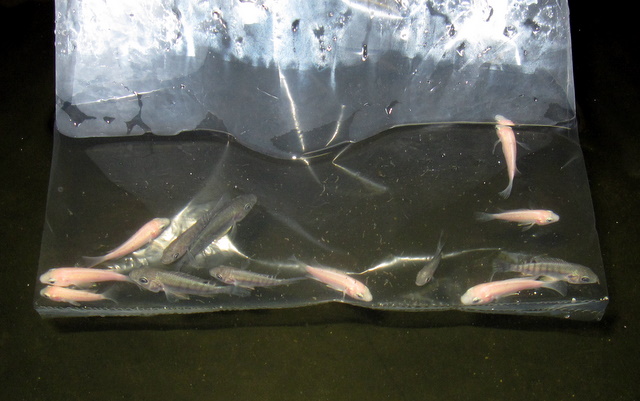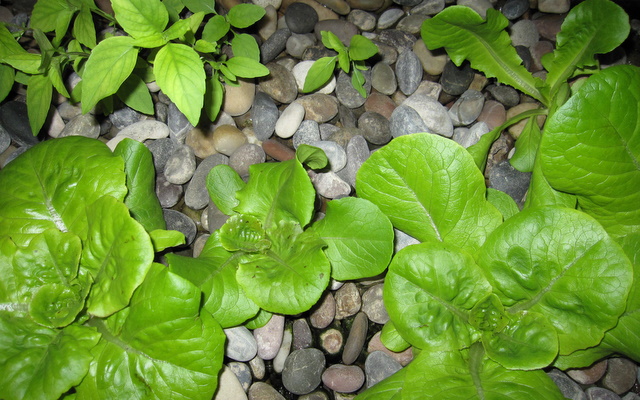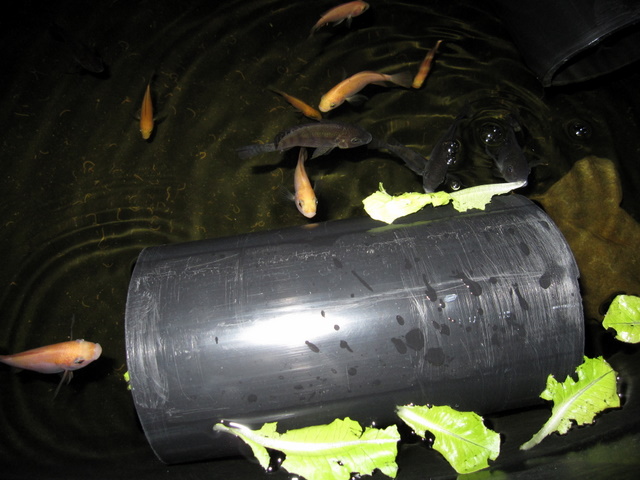
(a) Fish Tank
- 100 Gallons Fish Tank.
- Once you get into aquaponics, everything start looking like a fish tank (e.g. snapset pool). Used IBC containers can be modified to quickly setup a system. Also, widely used are 55 gallons barrels.
(b) Fish
- Fish used: Tilapia (a blue strain, and a pink hybrid strain), Mosquito Fish
- Other fish we can use: trout, perch, goldfish, koi, etc.
- Tilapia were chosen for their ease of breeding, disease resistance, and rapid growth rate. The down side is that it is a tropical fish and will require the water to be heated for the cold seasons.

Blue and pink tilapia fingerlings getting ready to be released into their new home.
(c) Grow Bed
- 25 gallons grow bed.
- Conventional wisdom says that the grow bed volume should be twice that of the fish tank. That means we would need 8 of these grow beds, this may be possible if we had a greenhouse/conservatory. However, our biggest constraint is the one grow light so we need to watch our stocking density, how much we feed the fish, and water parameters. Another option to consider is to add supplementary filtration like a bio filter on the side.
(d) Auto Siphon
- We are using the siphon to run flood and drain cycles in our grow bed.
- Many types of auto siphon may be used, we chose a u-bend/loop variation.

This is the auto siphon inside the grow bed before it is covered with river rocks. The gray PVC piece goes right through the bottom of the grow bed.
(e) Grow Bed Media
- LECA/Hydroton is the media of choice. It is light, easy on the hand and provide the surface area necessary for the nitrifying bacteria to process the fish waste. The disadvantage is that it can be expensive and not easily accessible to everyone.
- Gravel is a cheap and accessible alternative but its weight is a major drawback. The most painful job by far is cleaning the gravel. Do what you can to try to get it clean then cycle the system for a few days. The water will clear up and the nitrifying bacteria will establish themselves.
- An alternative worth mentioning is to use gravel for the bottom layer and LECA for the top layer. This allows you to adjust your mix per your preference. Optional is a grate/mesh in between for easy separation.
(f) Pump
(g) Plants
- All kinds of plants can be grown with aquaponics including leafy and fruiting ones.
- We use lettuce and basil daily in our meals, hence they are the main crops.

We've found that aquaponic lettuce/basil are much tastier than their supermarket counterparts. The comparison would be that of veal to regular beef, sans the animal welfare issue.
(h) Light
- Since we're planning on growing only leafy plants, we choose a fluorescent grow light emitting the cooler end of the light spectrum (65000K).
(i) Composting Worms
- This is an attempt to incorporate vermicomposting into our mini ecosystem. The idea is to have the worms help break down the fish waste and have another source of supplemental feed for the fish. The siphon could pull some unlucky worms into the fish tank or you may get them while pulling up root balls.
- The worms used are Eisenia Fetida. These are composting worms as oppose to typical earthworms. After adding a couple of worms to the system, we had no idea they survived until we found cocoons weeks later in the grow bed. Not only did they survive, it appears that they are thriving.
- Snails managed to find their way into our system from our pond. There is a concern that they will clog the plumbings, otherwise they should help break down materials and the fish would take them as food as well. We expect them to do no harm, but add yet another dimension to our living system.
(j) Heater
(k) Fish Food
- Commercial fish food.
- Duckweed.
- Vegetable (i.e. unused lettuce/basil from grow bed).
- Insects, worms and grubs found in garden (also composting worms from grow bed).

Blue and pink tilapia feasting on some lettuce treats from the grow bed (sometimes we can't use them all). Four inch PVC tube shown here is placed in the fish tank to provide some hiding places for the less aggressive fish.
